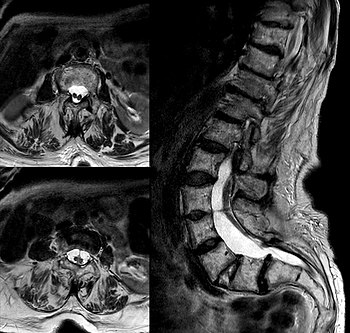Diastematomyelia
| Diastematomyelia | |
|---|---|
 | |
| Diastematomelia in MRI of lumbar spine. | |
| Specialty | Medical genetics |
Diastematomyelia (occasionally diastomyelia) is a
Signs and symptoms
The signs and symptoms of diastematomyelia may appear at any time of life, although the
The course of the disorder is progressive. In children, symptoms may include the "
. In adulthood, the signs and symptoms often include progressive sensory and motor problems and loss of bowel and bladder control. This delayed presentation of symptoms is related to the degree of strain placed on the spinal cord over time. Tethered spinal cord syndrome appears to be the result of improper growth of the neural tube during fetal development, and is closely linked to spina bifida.Tethering may also develop after spinal cord injury and scar tissue can block the flow of fluids around the spinal cord. Fluid pressure may cause
Cervical diastematomyelia can become symptomatic as a result of acute trauma, and can cause major neurological deficits, like hemiparesis, to result from otherwise mild trauma.[2]
The following definitions may help to understand some of the related entities:[citation needed]
- Diastematomyelia (di·a·stem·a·to·my·elia) is a congenital anomaly, often associated with spina bifida, in which the spinal cord is split into halves by a bony spicule or fibrous band, each half being surrounded by a dural sac.
- Myeloschisis (my·elos·chi·sis) is a developmental anomaly characterized by a cleft spinal cord, owing to failure of the neural plate to form a complete neural tubeor to rupture of the neural tube after closure.
- Diplomyelia (diplo.my.elia) is a true duplication of spinal cord in which these are two dural sacs with two pairs of anterior and posterior nerve roots.
Pathophysiology
Diastematomyelia is a "
Diastematomyelia usually occurs between 9th
Diagnosis
Adult presentation in diastematomyelia is unusual. With modern imaging techniques, various types of spinal
Treatment
Surgery
Surgical intervention is warranted in patients who present with new onset neurological signs and symptoms or have a history of progressive neurological manifestations that can be related to this abnormality. The surgical procedure required for the effective treatment of diastematomyelia includes decompression (surgery) of neural elements and removal of bony spur. This may be accomplished with or without resection and repair of the duplicated dural sacs. Resection and repair of the duplicated dural sacs is preferred since the dural abnormality may partly contribute to the "tethering" process responsible for the symptoms of this condition.
Post-myelographic CT scanning provides individualized detailed maps that enable surgical treatment of cervical diastematomyelia, first performed in 1983.[2][3]
Observation
Asymptomatic patients do not require surgical treatment. These patients should have regular neurological examinations since it is known that the condition can deteriorate. If any progression is identified, then a resection should be performed.
References
- ISBN 978-0-12-385158-1. Retrieved 28 February 2023.
- ^ a b Kuchner, E.F., Anand, A.K. & Kaufman, B.M., "Cervical Diastematomyelia" Neurosurgery, 16(4): 538-542, 1985
- ^ Anand, A.K., Baim, R.S. & Kuchner, E.F., "Cervical Diastematomyelia" Computerized Radiology. 9(1):45-49, 1985
